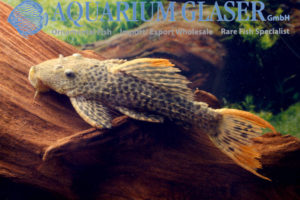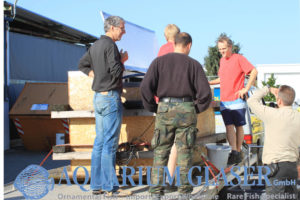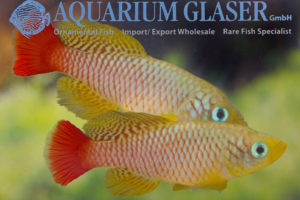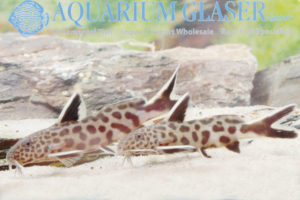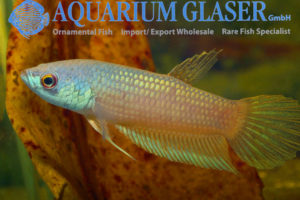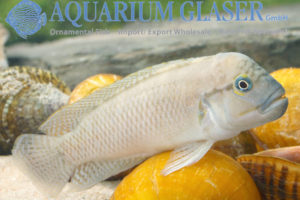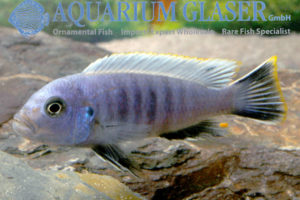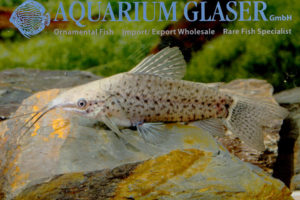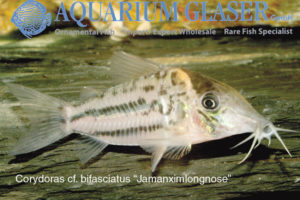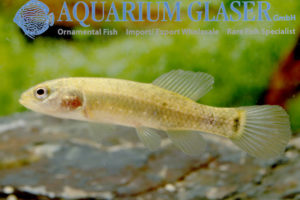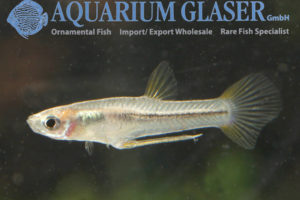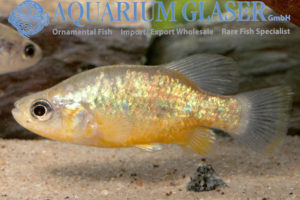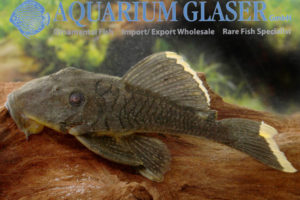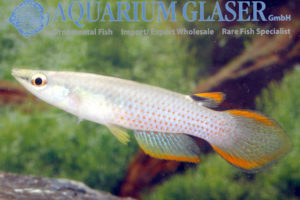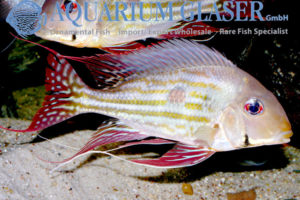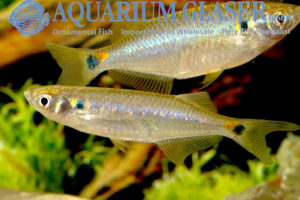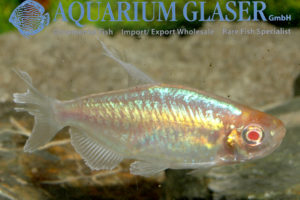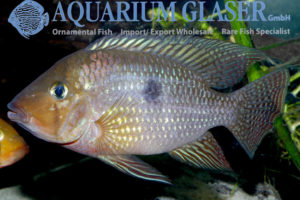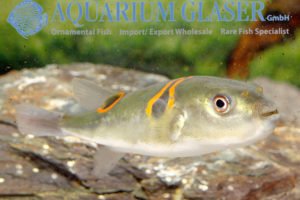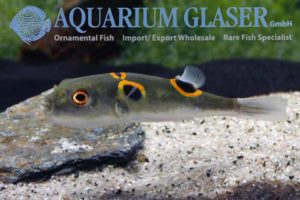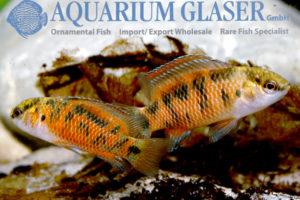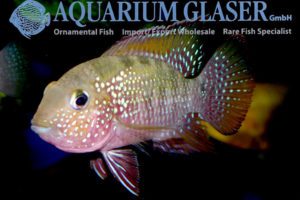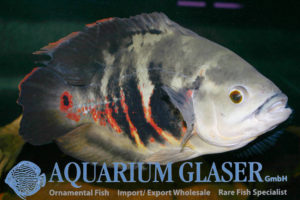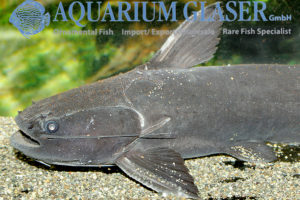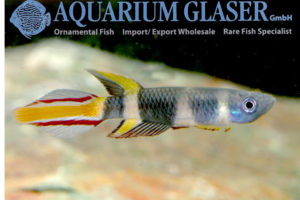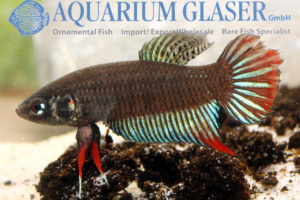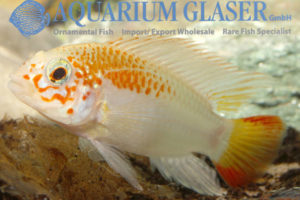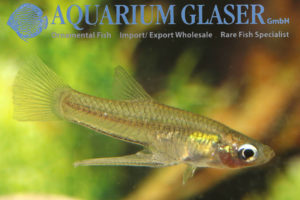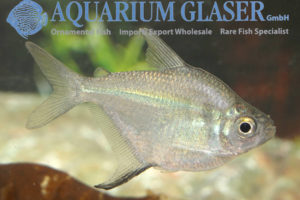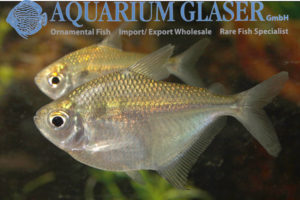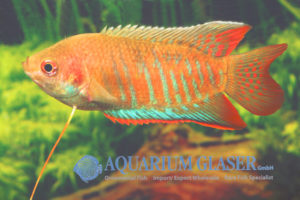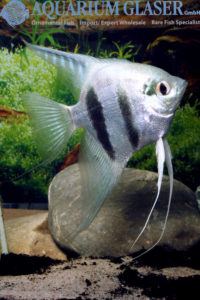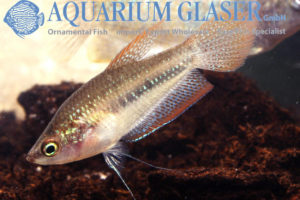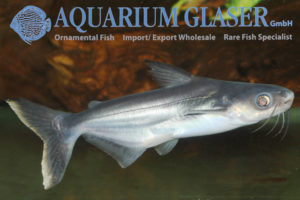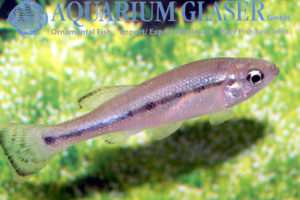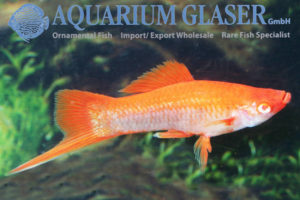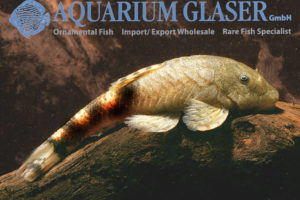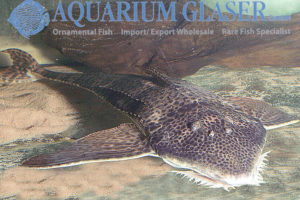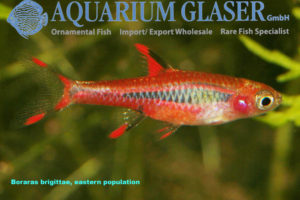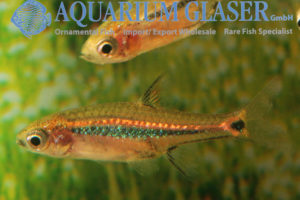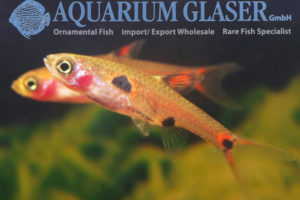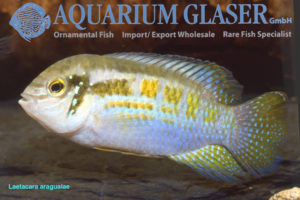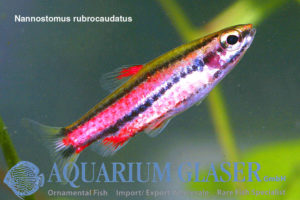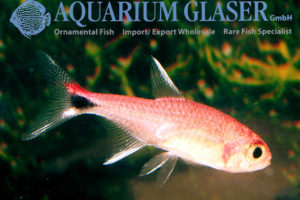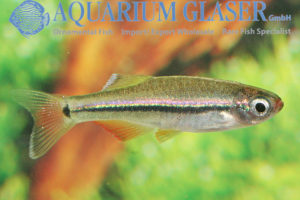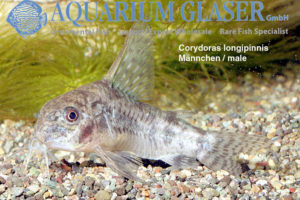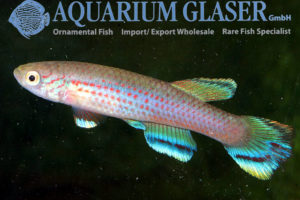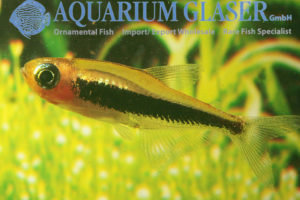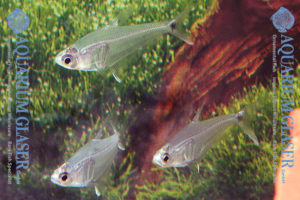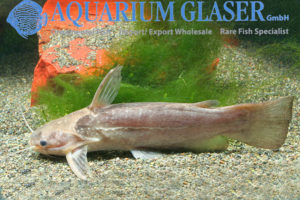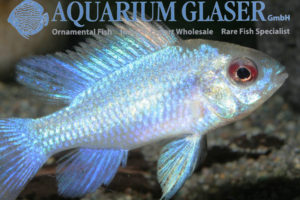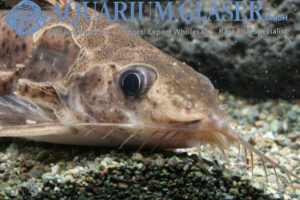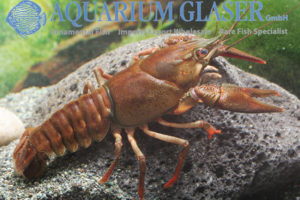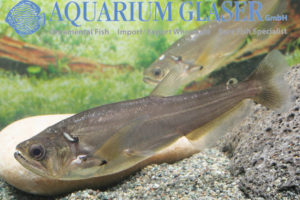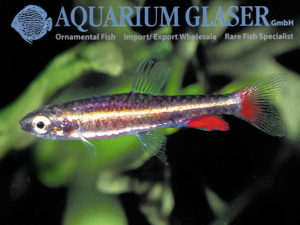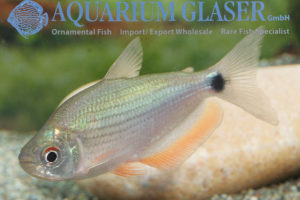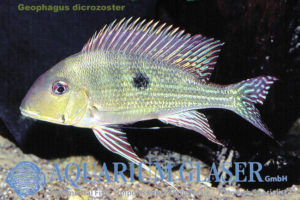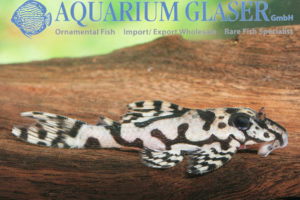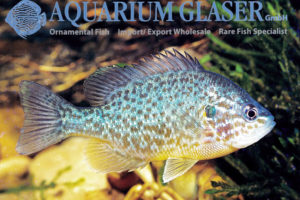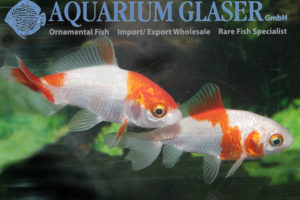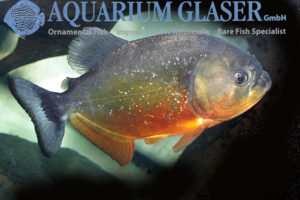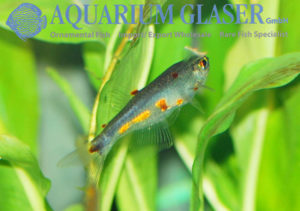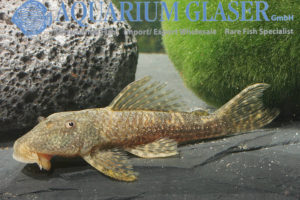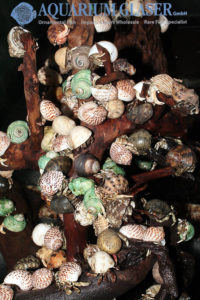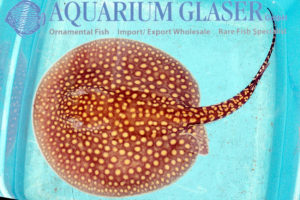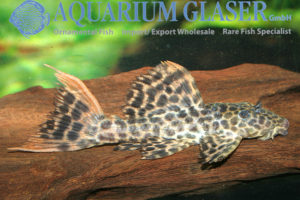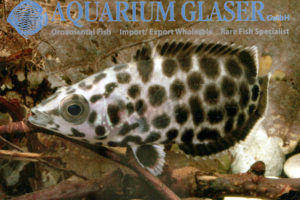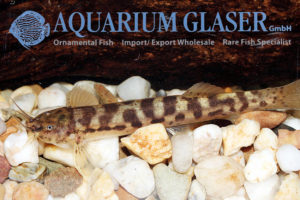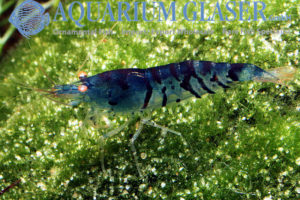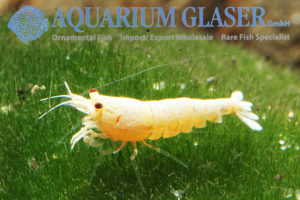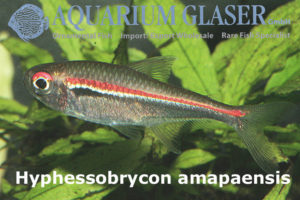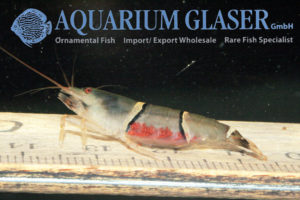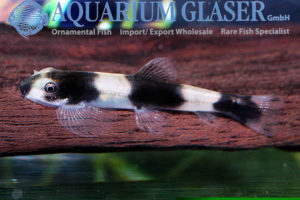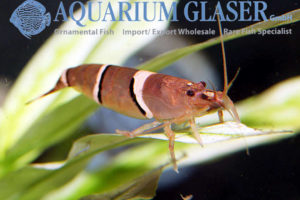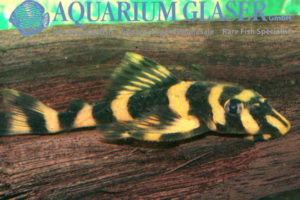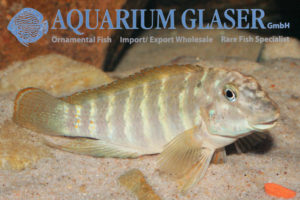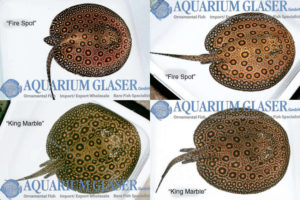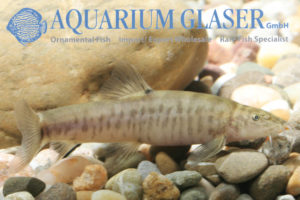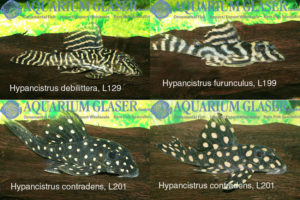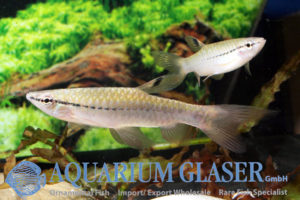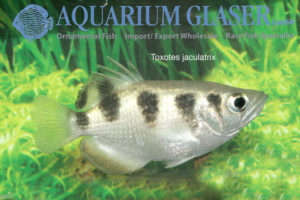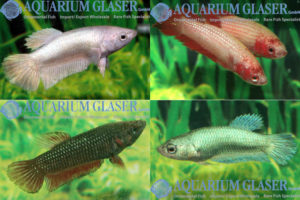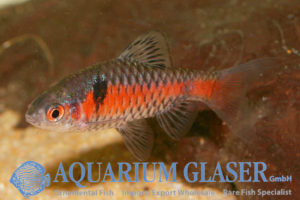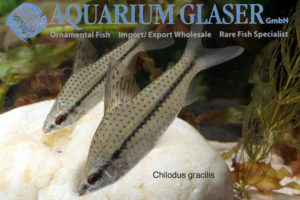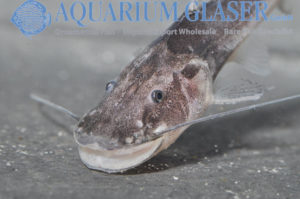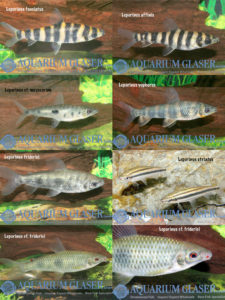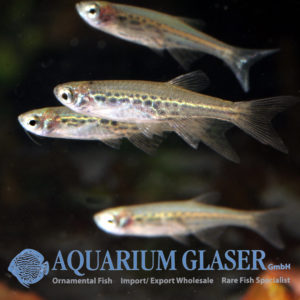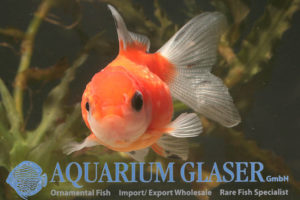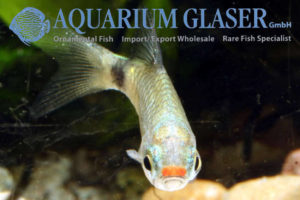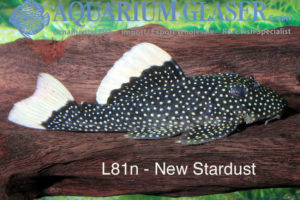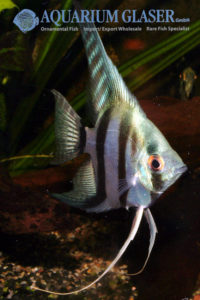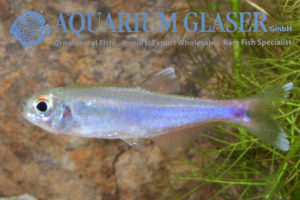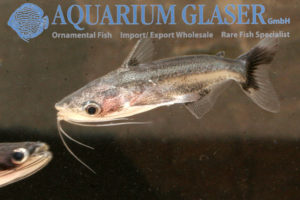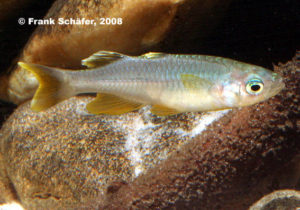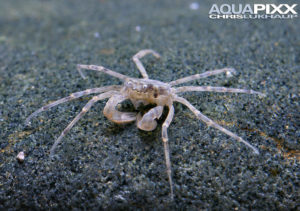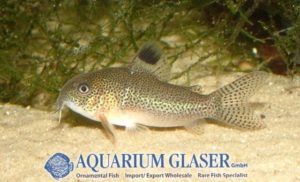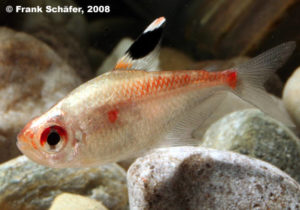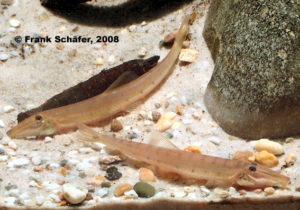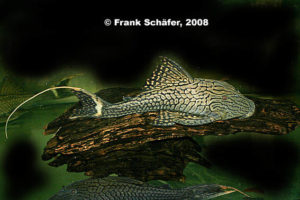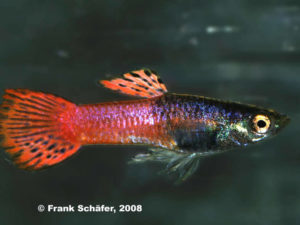The genus Pseudacanthicus currently comprises five described species. Three of them are known as aquarium fish. Additionally there are 16 L-numbers given for species of Pseudacanthicus which represent either species new for science or have a doubtful identity. Species of Pseudacanthicus are also known under their popular name “cactus catfish”, for the species are very […]
Fish Archive (3089)
-
-
Phractocephalus hemiliopterus
At Aquarium Glaser not only small fish for private community tanks are stocked, but also real rarities for scientific institutions and large fish for public aquaria and zoos. A specimen for the latter category reached us now: a gigantic Phractocephalus hemiliopterus, more than 80 cm long. We stocked the fish for a Russian customer. The […]
-
Nothobranchius foerschi
Nothobranchs (genus Nothobranchius) belong to the most colorful species of freshwater fish. This is true at least for the males, as female nothobranchs are all more or less unicolored. Nothobranchs are typical seasonal fish. They outlive the desiccation of their habitat with eggs that can survive without water almost unlimited. Nothobranchius furzeri is world famous […]
-
Synodontis lucipinna (= dwarf petricola)
This beautiful Synodontis is a real dwarf compared with its numerous congeneers: it reaches only 8-10 cm (very old specimens in extreme spacy aquaria may reach 15 cm). In the hobby it became popular under the name “dwarf petricola”. Some species of Synodontis occuring in Lake Tanganyika (where S. lucipinnis is an endemic species) have […]
-
Betta kuehnei
The mouthbrooding fighting fishes of the Betta pugnax group are wideley spread over Thailand, Malaysia and Indonesia. The most currently described species is Betta kuehnei from the northernmost Province Kelantan of Malaysia and the southernmost parts of Thailand. The species has been discovered by the travelling aquarist Jens Kühne and introduced in the hobby as […]
-
Telmatochromis temporalis
Snail-cichlids are a specialty of Lake Tanganyika. Of course also other places on earth exist where empty shells of snails are used by fish for hiding or breeding. But nowhere else than in Lake Tanganyika are so many specialized species. In Lake Tanganyika real fields of empty snail-shells exist. Empty shells that lie here and […]
-
Cynotilapia axelrodi
Currently we have received beautiful C. axelrodi from a breeder. The animals are full in colour and about 4-6 cm long. Maximum length for this species is given around 9 cm. Cynotilapia are typical mbuna cichlids. They differ from the closely related Maylandia (the zebras) by the dentition. Keeping is identical, which means they need […]
-
Hoplosternum punctatum
Plated catfish from the genus Hoplosternum are known in the hobby mainly from relatively large growing species, which can reach 15 to 20 cm in length. However, there also exist small species, like H. punctatum, which hardly grows larger than 7 cm. The natural distribution of this species is in Panama and in the rivers […]
-
Corydoras from the Rio Jamanxim – C. bifasciatus?
From the Rio Jamanxim in the state of Pará, Brazil, we received for the second time now beautiful Corydoras catfish. The Rio Jamanxim is a tribute to the Rio Tapajós. The first shipment of corys from there contained only long snouted animals, whereas the second shipment contained the shortsnouted counterpart. The new corys remind one […]
-
Umbra pygmaea
The mudminnows (Umbra) are relicts from the ice age and nowadays found only in remainings of their initial territory. Three species are still extant, two of them in North America and one in Europe. The European species (U. krameri) is in danger of extinction due to habitat destruction. Mudminnows are inhabitants of extreme biotopes: swampy […]
-
Poeciliopsis prolifica – Blackstripe livebearer
This tiny species of livebearer originates from northwestern Mexico. The males reach a maximum length of 2 cm, the females of 3.5 cm. At the first glimpse the fish look somewhat unspectacular, but no one who keeps the fish has regrets about it. The whole day through the males are after the females or fight […]
-
Xenotoca variata – Jeweled splitfin
Only few species of splitfin (Goodeidae) have become established aquarium fish, despite the fact that they are perfectly suited for keeping and breeding in tanks. Many species are in danger of extinction in the wild, for they inhabit only very small areas and habitat destruction can easily wipe out complete species. Species conservation via breeding […]
-
A new L-catfish!
Last week we were able to import a new yellow seam pleco belonging to the genus Baryancistrus. The fish originate from Sao Felix at the Rio Xingu. They differ from all other members of the genus from there (L18, L47, L81, L85, L177) by the almost black ground colour of the body. Almost no spots […]
-
A new Panchax from Manipur
After the spectacular importation of the new gourami from Manipur (http://www.aquarium-glaser.de/en/colisa-cf-fasciata-_en_1115.html) now we were able to import a beautiful new Panchax from this state in northern India. Currently only one species is accepted formally within this species-group, eg Aplocheilus panchax. This species is distributed from China over great parts of India, Burma, and Indochina (Thailand, […]
-
Geophagus winemilleri
The main distribution of Geophagus winemilleri is the southern part of Venezuela. Nevertheless most imports come from Brazil, because the species also occurs in the Rio Negro. G. winemilleri becomes often confused with G. proximus and a second, still undescribed or unidentified species. However, G. winemilleri can be identified by the dark spot on the […]
-
Chela laubuca
Currently we offer a beautiful surface dwelling fish for community tanks for fishes from Asia: Chela laubuca. The absolutely peaceful species attains a total length of around 6 (rarely 8) cm. Keeping and breeding is comparable to that of the zebrafish (Danio rerio) which shares the same habitats as Chela laubuca in nature. Text & […]
-
Phenacogrammus interruptus “Albino”
Currently we receive beautiful cultivated albino Congo Tetras from Indonesia. Like in all true albinos the eyes of the fish are red due to the genetically caused lack of black body pigment (melanin). In many other species of fish albinos have a uniform whitish, yellowish or flesh-coloured body. Not so in the Congo Tetra. The […]
-
Geophagus sp. „Rio Sao Francisco“
This pearl cichlid from the Rio São Francisco can reach a total length of about 25 cm and thus should be kept in relatively large aquaria of 400 litres and more. Although pearl cichlids are known to be relatively aggressive this particular species is quite peaceful if the tank is large enough. Even when taking […]
-
Takifugu ocellatus
We were able to import one of the most beautiful freshwater puffers from China again: Takifugu ocellatus. This fish shows us that the terms “freshwater fish” and “marine fish” can be applied on the very same species. Like salmon these puffers live in pure freshwater during their youth and then go to the sea where […]
-
Takifugu ocellatus
After many long years we were finally able again to import this most beautiful pufferfish. For more informations on the species, please see http://www.aquariumglaser.de/en/archiv.php?news_id=207 For our customers: the animals have code 456363 on our stocklist. Please note that we exclusively supply the wholesale trade. Text & photos: Frank Schäfer
-
Badis “Piebald”
Currently among the specimens of Badis badis bred by commercial breeders relatively often aberrant specimens are found. A closer look on these fishes reveils that besides the unusual irregular black pattern the basic body colour is a deep red. There can be no doubt that these animals are hybrids. Quite recently only one species with […]
-
Bujurquina oenolaemus
Bujurquina oenolaemus: This very pretty species of Bujurquina originates from Bolivia and was described scientifically as early as 1987 by Kullander. It took almost 20 years before the first living specimens were brought to Austria, Switzerland and Germany by travelling aquarists. Soon after breeding was successful and so the species was spread in the hobby. […]
-
Astronotus sp. „Bahia Red“
Sadly it was not possible to research if this Astronotus really was collected in the Brazil state of Bahia. Currently no scientific reports of the occurence of the genus in Bahia are known. So we have to leave the question open, if this population was brought to Bahia as a food fish or if they […]
-
Trachycorystes trachycorystes
This bizarre species has been described scientifically already in 1840. It is widely distributed in the whole Amazon basin. Nevertheless it becomes only rarely imported and so it is highly demanded by fans of predatory catfish who pay quite high prices for them. The species can attain a total length of about 45 cm. We […]
-
Pseudepiplatys annulatus
Currently we can offer wonderful bred Pseudepiplatys annulatus. This tiny species originates from West Africa, the fish we have in stock were bred in Southeast Asia. Maximum length of the male is around 3 cm, females stay even smaller. The species is completely peaceful against all other fish and an ideal choice for so called […]
-
Betta siamorientalis
(formerly: Betta cf. imbellis „Vietnam Black“). We import from Vietnam a pretty wild collected Betta for some time now. The exact determination of that species proofed to be quite complicated. There are four scientifically described species from this complex: Betta imbellis, B. smaragdina, B. splendens, and B. stiktos. An additional species is already known in […]
-
Apistogramma viejita GOLD
For the first time we can offer now this beautiful dwarf cichlid in a golden sport. This sport does not occur in nature. The contrasting golden and red colours make the fish extremely attractive. As Apistogramma viejita originates from Colombia it should be kept at higher temperatures as usual, eg 26 – 28°C. Water should […]
-
Giradinus falcatus
Aquarists usually think of the African killifishes of the genus Aplocheilichthys when they hear the term „lampeye fish“. However, there are also lampeyes among the livebearers! One of them is Giradinus falcatus. The shining eyes of the fish have the same sense as in their African cousins: they are used to keep the school together. […]
-
Orthospinus franciscensis
For the first time we were able to import the tetra Orthospinus franciscensis which is endemic to the Rio Sao Francisco in Brazil. Keeping and also probably breeding is the same as in the Silver Dollar (Brachychalcinus orbicularis) (http://www.aquarium-glaser.de/en/brachychalcinus-orbicularis_en_1116.html). However, O. franciscensis stays smaller, reaching only 8 cm maximum length. Lexicon: Orthospinus means “erected spine” […]
-
Brachychalcinus orbicularis
Brachychalcinus orbicularis is also known in the hobby under the name “Silver Dollar Tetra”, which might lead, however, to confusion with tetras of the genus Metynnis, which are also called “Silver Dollars”. Ephippicharax orbicularis is a well known synonym for our fish, which is quite popular in the hobby despite the fact that it displays […]
-
Colisa cf. fasciata
The northern states of India are hardly researched in respect of the fishes. From the state of Manipur we currently received exceptionally colorful gouramis of the genus Colisa, which represent a species new to science. They are without doubt close relatives of the species Colisa fasciata, C. bejeus, and C. labiosa, but differ from all […]
-
Blue Angel Showsize
In January 2009 we presented to you the new blue dwarf angel (http://www.aquarium-glaser.de/en/pterophyllum-scalare-blauer-zwerg–blue-dwarf_en_1071.html). In the meantime the breeders were pretty active and crossed the blue dwarfs onother strains of angels. So now we are able to supply also blue angels in showsize, which are almost as big as angels of other colour varieties. Text & […]
-
Trichopsis schalleri „Vietnam“
The genus Trichopsis (Croaking gouramis) currently comprises three accepted species: T. vittata, T. pumila, and T. schalleri. This hardly reflects the reality. Especially T. vittata seems to be catch-all species and represents a number of undescribed species. Trichopsis schalleri was known so far from Thailand only. We now get this pretty species also from Vietnam. […]
-
Pangasius bocourti
Shark catfishes have received their common name according to their swimming behaviour, which is very similar to the way several species of shark do swim. Similar to sharks is also that the fishes do permanently swim and only seldom take a rest.Nowadays they are also well known by their scientific genus name, eg Pangasius, because […]
-
Ilyodon whitei
The genus Ilyodon currently comprises 4 or 5 species (the status of I. lennoni is under discussion). Like all livebearing members of the family Goodeidae (splitfins) they are restricted to the highlands of Mexico. Ilyodon whitei lives in the upper tributaries of the Rio Balsas on the Pacific slope of Mexico. The peaceful and elegant […]
-
Xiphophorus hellerii Platin Orange
Xiphophorus hellerii Platin Orange: The latest sport in swordtails is this gorgeous variety. In swordtails exists an interesting gentic phenomenon. The gene for „albino“can be combined with body colours, if the body colours derive from a cross with platyfish. A real albino swordtail has red eyes and a whitish body. In the Platin Orange swordtail […]
-
Lampiella gibbosa
This charming little catfish species was described as early as 1908 by Miranda Ribeiro under the name Otocinclus gibbosus. But only when a group of reseaching aquarists (H.-G. Evers, M. Lacerda, and M. Beyer) managed to cellect the fish alive it became clear, how distinct from all other Otocinlus-like fishes this species really is. There […]
-
Loricaria lentiginosa
For the first time ever we were able to import one of the largest species of Loricarai, namely L. lentiginosa. The magnificent animals are about 40 cm long and thus fully grown. Like in all species of Loricaria they are paternal mouthbrooders. The male transports the eggs that stick together with its moutn until they […]
-
Boraras brigittae & Boraras merah
Dieter Vogt described in 1978 a subspecies of Rasbora urophthalma (please see the entry for Boraras urophthalmoides in our fisharchives) from Borneo. He named the fish Rasbora urophthalma brigittae, a dedication name in honour for his wife Brigitte. The German name is „mosquito rasbora“. This is not because the fish are as tiny as mosquitos […]
-
Boraras urophthalmoides (formerly Rasbora urophthalma)
As early as 1914 the then very prominent German aquarist J. P. Arnold illustrated a new species of Rasbora in a German aquarium magazine, imported by the company Scholze & Pötzsche and said to be imported from Sumatra. In 1922 E. Ahl from Berlin Museum described this species scientifically as Rasbora urophthalma and since these […]
-
Boraras maculatus
The Dwarf rasbora (Boraras maculatus, formerly known as Rasbora maculata) is the species of genus Boraras (which currently comprises five species, all of them will become presented in the upcoming days) that is known for the longest time in the hobby. None of these species grows bigger than 2-3 cm and thus they are perfect […]
-
Laetacara araguaiae, Laetacara fulvipinnis
Laetacara sp. „Buckelkopf“ described scientifically Laetacara sp. „Buckelkopf“ is known in the hobby for many years already. The somewhat unusal common name (the German word „Buckelkopf“ means „humphead“) derives from the feature developed by some very old males, but this happens rather seldom. It is a typical dwarf cichlid, the males grow to a length […]
-
Nannostomus sp. „Purple“ has been scientifically decribed as N. rubrocaudatus!
A strikingly beautiful Nannostomus species from Peru, known in the trade under the names Nannostomus marginatus „Purple“ or N. marginatus „Red“ for some time already, has now been described scientifically by Axel Zarske from Senckenberg Naturhistorische Sammlungen Dresden, Museum für Tierkunde as Nannostomus rubrocaudatus. The type specimens originated from Peru and were imported by our […]
-
Axelrodia riesei – Ruby tetra
Once more we were able to import a good number of beautiful Axelrodia riesei from Colombia. These tiny little fish – wild collected animals are sexually mature at a size of 1.5-2 cm, in aquaria they can reach a size up to 3 cm – fully deserve their popular name – they are brillant ruby […]
-
Tanichthys micagemmae – Jewel minnow
Currently two species f the genus Tanichthys are known in the hobby: the White Cloud Mountain minnow Tanichthys albonubes, and the Jewel Minnow, T. micagemmae. The White Cloud is available exclusively as bred specimens, wheras the Jewel minnows is also imported as wild collected fish. The Jewel minnow has been discovered in 2001 in Central […]
-
Corydoras longipinnis
We were able to import a new Corydoras species from Argentina, namely Corydoras longipinnis. This species has been scientifically described as recently as 2007 by Joachim Knaack. The new species is a close relative to the well known Corydoars paleatus and reminds one somewhat of the longfinned sport of that species. In Corydoras longipinnis only […]
-
Aphyosemion celiae celiae
Killifishes of the genus Aphyosemion are among the most colorful fishes of the World. They become only a few centimetres long (in the case of Aphyosemion celiae: about 5 cm). Many killifishes are thought to be short living, delicate fish, aggressive towards other fish and difficult to maintain. A. celiae belongs to the species that […]
-
Tucanoichthys tucano
Once more we were able to import a real jewel among the tetras for the first time ever: Tucanoichthys tucano. This tiny little species attains a maximum length of around 2 cm and is thatfore an ideal fish for nano aquaria. Tucanoichthys lives endemic in the upper Rio Negro basin, to be more precise in […]
-
Mountain crystal tetra, Leptagoniates pi
Glassfishes occur in many fish families. In the hobby we know for example glass perches (Parambassis etc.) and glass catfishes (Kryptopterus); occasionally also glass gobies (Gobiopterus) and Crystal danios (Danionella) are kept in aquaria. All these fishes come from South and South East Asia. Now we were able to import from South America a species […]
-
Trachelyopterus galeatus
Already in 1766 this species was described under the name Silurus galeatus by the founder of the zoological nomenclature, Carl von Linné. It is extremely widespread in South America. Today this fish is classified in the family Auchenipteridae, and within this family in the subfamily Auchenipterinae. The species in Auchenipterinae share a very special feature: […]
-
Mikrogeophagus ramirezi „Electric Blue“
The Ram is one of the most beautiful aquarium fishes. The wild Ram originates from the llanos of the Orinoco. The newest sport of this dwarf cichlids is blue all over the body. It is virtually impossible to illustrate this very special colour in a high resolution picture. Only reducing the resolution brings the effect […]
-
Opsodoras stuebelii
The Doradidae family contains around 90 species in about 35 genera. Thus they represent only a minority among the huge number of catfishes existing in South America. But all dordadid catfishes are really bizzarre and desirable creatures for catfish enthusiasts. There are dordaid catfishes that reach around one metre in length, but for Opsodoras stuebelii […]
-
Astacus astacus
The Noble or River cray, Astacus astacus, is sadly in danger of extinction in central Europe. The reason for this are the extreme destruction of the natural habitats in combination with the introduction of a Northamerican species between 1860 and 1870. This species, the so-called Camber cray (Orconectes limosus) was infested with a disease. This […]
-
Hydrolycus scomberoides
The Dogtooth characins (Hydrolycus) are small genus of tetras (four species) that have a wide distribution in tropical South America. They have in common very long saber-like teeth in the lower jaw. In the upper jaw cave-like notches are present, as otherwise the fish would not be able to close the mouth. These saber-teeth are […]
-
Nannostomus anduzei
For the first time ever we were able to import this tiny fish in larger numbers. Until now the fish was available only by accidental by-catches. Please read more about this new jewel for nano tanks: Within the family Lebiasinidae, sixteen scientifically accepted species of the genus Nannostomus are known. Still, in aquatic specialist shops […]
-
Markiana nigripinnis
We were able to import one of the most unusual tetras again: Markiana nigripinnis. Our specimens originate from Argentina. The species inhabits the river basins of the Paraná, Paraguay and the Marmoré (Argentina, Bolivia, Brazil, Paraguay). Due to the southern subtropical region where the fish occurs it is not necessary to install a heater in […]
-
Geophagus dicrozoster and G. abalios
The beautiful eartheaters of the Geophagus-surinamensis relationship are among the most colorful cichlids, shining in all colours of the rainbow. There are numerous species and some of them even have colour varieties in different river systems. As these are currently not recognized by scientists, we help ourselves in adding the river´s name behind the scientific […]
-
Hypancistrus L236xx
The Brazilian species of the genus Hypancistrus are currently not allowed to be exported from the country. Thus L-numbers of this genus, like L236 from the Rio Iriri, are available as bred specimens only. Among the last brood we received was one extraordinary specimen, which is depicted here. Text & Photo: Frank Schäfer
-
Lepomis gibbosus
The pumpkinseed (Lepomis gibbosus) is one of the most beautiful coldwater fishes. Moreover it has a very interesting behaviour. The species originates from central parts of the North American continent. The continental climate (hot summers, cold winters) makes the pumkinseed a hardy fish and so it was transferred by humans to many regions as a […]
-
Wakin Hoe Kim
Goldfish are timeless classics. The number of different sports and colours seems to be neverending. Basicly all goldfish belong to the very same species, eg Carassius auratus. So every single sport is a mere variety and all the different goldfish can be crossed with each other. Most of the varieties that exist nowadays have a […]
-
Pygocentrus piraya
The „real“ piranha, Pygocentrus piraya, is restricted to the river system of the Sao Francisco in southern Brazil. It is a up to 30 cm long species, which is characterized by its deep red breast and the mighty jaws when it is fully grown.However, even juveniles display a very attractive coloration. Most piranha species belong […]
-
Available again: Pterobrycon myrnae, the Semaphore tetra
New stock arrived for first calendar week 2010 And the good news is: the are considerably more favourable than last year! It was only twice, 1998 and 2008, that we received the Semaphore Tetra by Thomas Schulz. This fish is restricted to fast running brooks in Costa Rica. It is a spectacular tetra and luckily […]
-
A new pleco from the Rio Sao Francisco
The Rio Sao Francisco is a large river in southern Brazil. It´s length is around 3.200 km. The ichthyofauna of the Sao Francisco is comparably good explored, as there plans for an irrigation project. So the environment has to be explored and there were and are several studies on the fish fauna. We currently received […]
-
Land hermits: Coenobita rugosus imported!
From Taiwan we were able to import beautiful land hermits. They belong to the species Coenobita rugosus, which can be recognized by the ridge-like swellings on the upper edges of the claws. The colour is very variable and can be grey, brown or reddish. Like all Coenobita species the animal likes to live in groups. […]
-
Potamotrygon cf. falkneri
Currently we have a great selection of wonderful river stingrays from Paraguay belonging to that species in stock. As in all river stingray species, each individual has its own colour pattern, which differs clearly from all other congeneers. This is one of the reasons why species can only be distinguished with great difficulties in Potamotrygon. […]
-
Just in: L114
After some time we were able now to import again L114. It is a member of the beautiful Pseudacanthicus-leopardus species group. The members of this species group can reach 25-30 cm total length, some sources give even 40 cm. They originate from the Rio Negro basin near Barcelos in Brazil. They are omnivorous, but prefer […]
-
Ctenopoma acutirostre Leopard babies!
Among the most beautiful anabantoids or labyrinth fish from Africa is Ctenopoma acutirostre, the Leopard bushfish. It can become 15-20 cm long. Its natural habitat is the Congo. It is collected there for the ornamental fish trade in the Stanley Pool region. Here the fish live under the swimming meadows of the water hyacinth (Eichhornia […]
-
Trichomycterus alternatus: In the shadow of the vampire
female Sometimes fishes have the same problems as human beings: one cannot choose his relatives! And so the good reputation of a small fish sometimes is destroyed due to the bad one of a cousin. The most by far feared species of fish in South America is the so-called candiru. In fact, the name candiru […]
-
Neocaridina Deep Blue Tiger Yellow Eyes
The latest new entry in our stocklist: this is a very beautiful sport of the tiger shrimp. The blue sport is known for quite a long time. Our new stock shows extreme bright colours. Males can grow to a size of 2.5 cm, females become 3.5 cm long. For our customers: the animals have the […]
-
Neocaridina Red-Bee-Snow-White-Shrimp
Breeding of „Crystal Red“ shrimps has become a widespread hobby. These dwarf shrimps are real pets in the sense of domesticated animals, a very interesting fact under the aspect of culture history: this is the first case of a crustacean that has been cultivated for that reason since the rise of men on earth! A […]
-
Hyphessobrycon amapaensis
One of the most beautiful tetras of South America is availble now in brillantly colored wild collected specimens. The Amapa tetra is an uncomparable eye-catcher for any well suited community tank for South American fishes. As usual, among these wild collected fishes were also specimens of other species, so-called by-catches. This gives us a good […]
-
Bamboo shrimps actually spawned
Last week we could introduce to you the new Bamboo shrimp, which we imported for the first time ever from Taiwan. Due to the extreme high price of the two alleged pairs we established them not in the fish house, but in our show room. Yesterday a scientist researching on these shrimps asked us about […]
-
Protomyzon pachychilus
For the first time we were able to import these charming hillstream loaches. Due to their origin (China) and their black&white coloration we call them dwarf panda hillstream loaches. Although the species has been scientifically described back in 1980 in a Chinese journal almost nothing has been published concerning the beautiful animal since then. Our […]
-
Sensation: Bamboo shrimp from Taiwan
We are proud and happy that we were able to import yesterday the first few pairs of a new shrimp from Taiwan. According to the local scientists it belongs to a so far undescribed species. There is no doubt that it belongs to the Atya-relatives. The males of the „Bamboo shrimp“ are almost two times as […]
-
Wonderful German bred Zonancistrus pulcher (L168) arrived!
Photo: Frank Schäfer
-
Eretmodus cyanostictus “Makombe”
Actually we can offer very pretty Tanganyika Clowns, Eretmodus cyanostictus, from Makombe. Like so many other cichlids from the lake they have developed a lot of different geographical varieties. Eretmodus are highly specialized fishes. In the wild they live in the very shallow water of the shore. Here, in the surf, they feed on aufwuchs. […]
-
Great variety of freshwater stingrays available at Aquarium Glaser
The export stop of freshwater stingrays (Potamotrygon) has ended and so the very much sought after black species (P. henlei and P. leopoldi) are regulary available now again. Beside these Brazilian black rays we have astonishing Flower rays (P. schroederi) from Colombia and Venezuela, fantastic „King Marble”and Fire Spot” from Colombia (called P. motoro in […]
-
Schistura cf. jarutanini
The brook loaches of the genus Schistura are far spread over South and Southeast Asia. There are hundreds of species, most of them still scientifically undescribed. Almost each flowing water has it´s own species. So it is no surprise that some of the species also became cave-dwellers. We could import a small number of individuals […]
-
Import season for Orinoco-Plecos has startet!
The Rio Orinoco is with more than 2.000 km length one of the biggest rivers of South America. About 3/4 of it´s length it runs through Venezuela, the remaining 1/4 belong to the territory of Colombia. The Brazo Casiquiare connects during high water levels the Orinoco-sytem with the Amazon-sytem via the Rio Negro. The import […]
-
Pyrrhulina laeta
It is quite long ago that we were able to import this wonderful tetra. But now we can offer it again! Including the caudal fin the males can reach 12 cm in length. Males are generally larger than the females. A characteristical pattern for the species is the black line that extends to the level […]
-
Toxotes jaculatrix
Seven species of Archerfishes (Toxotes) are known. Three of them (T. lorentzi and T. kimberleyensis from Australia and T. microlepis from South East Asia) are usually found in fresh water. Two are practically unknown, at least they have not been kept in aquaria so far: T. blythi from Burma and T. oligolepis from the Moluccas. […]
-
Betta splendens
We have a new supplier for fighting fish (Betta splendens). Besides the amazing males (which we will introduce to you detailed in the near future) there are also wonderful females. Text & Fotos: Frank Schäfer
-
The Odessa barb has finally been named: Pethia padamya
There is a good number of well known aquarium fish that bear no scientific name, so they „officially” do not exist at all! Only with a formal scientific description a name can be applied to a species that is binding for every person in the world. On the other hand, common names can be given […]
-
Chilodus gracilis
There are four species of the small headstanders of the genus Chilodus. Only two of them appear in the hobby. According to reports the Spotted Headstander (Chilodus punctatus) is the most common species in the hobby. But, in fact, it is not. The species found most is Chilodus gracilis which can be distinguished from […]
-
Brachyplatystoma
The catfishes of the genus Brachyplatystoma are some of the most important foodfish in the basins of the Amazon, the Orinoco and the countries of the Guiana shield. Some of them may reach a length of 360 cm and a weight of 200 kg. Many thousand tons are landed each year, which led to local […]
-
A great number of Leporinus species in stock
Actually, Aquarium Glaser has many Leporinus species in stock. These are often very attractively coloured large tetras which are perfectly suited for large and show aquaria. Text & Photos: Frank Schäfer
-
Danio sp. Panther
The smallest species of Danio known so far was now imported by Aquarium Glaser after some time again from Burma. The species is termed Danio sp. “Panther”, as it is not described scientifically yet. It becomes only 2-3 cm long. It is a schooling species that fits perfectly to smaller aquaria. Temperature should be chosen […]
-
Pearlscale
The goldfish is the eldest ornamental fish species in the world. For hundreds of years it has been bred on highest levels. Although the western aquarium hobby is unthinkable without the goldfish and its varieties the main breeding centres are still located in the east of Asia. It is very important to know where a […]
-
Barbus erythromycter – Lipstick barb
The males of this unique dwarf barb (maximum size around 4 cm) have a red “walrus moustache”. Until the scientific description of the species in 2008 it was known in the trade as Barbus cf. puntio. Text & Photos: Frank Schäfer
-
Baryancistrus L18, L81, L81n, L177
The main collecting season of the beautiful gold seam sucker cats of the genus Baryancistrus starts around end of may and lasts until the end of september. Although these fishes are common in the wild, live in shallow waters and are traditionally used as food fish, they cannot be connected with one of the about […]
-
Pterophyllum scalare Blue Dwarf
In 1949 Werner Ladiges mentions a blue dwarf angel (Pterophyllum scalare) that appeared by chance (problably by mutation) in a large breeding stock before WW2. Beside its unique blue coloration a characteristicly feature of these fishes was their small adult size. They never grew bigger than 5 cm body height. Although this stock survived WW2 […]
-
Boehlkea fredcochui now Knodus borki
Dr. Axel Zarske found that the species imported for decades under the name Boehlkea fredcochui in truth represented a species of the genus Knodus so far unknown to science. The real Boehlkea fredcochui was now and then imported under the trade name Boehlkea sp. Sky Blue. So our good old aquarium fish is now named […]
-
Auchenipterus nigripinnis
For the first time ever we were able now to import a catfish from Argentina which is new for the hobby. It looks amazingly similar to the Asian shark, Pangasianodon hypophthalmus (a well known synonym of that species is Pangasius sutchi). The identification of the new fish wasn´t easy, but thanks to Ingo Seidel from […]
-
Telmatherina bonti
The Malili lake system on Sulawesi (former Celebes) is home of spectacular shrimps, snails and mussels which are exported for the hobby. Now the import of an endemic atherinoid species was successful, namely Telmatherina bonti. Like many atherinoides of the Malili lakes this species is polychromatic, which means that males and females appear in different […]
-
Limnopilos naiyanetri
Described in 1991, Limnopilos naiyanetri Chaung & Ng, has only just been discovered by the hobby. Crabs are found in pure freshwater in the roots of floating vegetation, ie. water hyacinth (Eichornia crassipes) and fine-leaved aquatic plants along the riparian zone (river banks). They have hairy bodies and appendages which collect mud and dirt and […]
-
Corydoras sp. „Uruara“ CW037
(Nov.13th 2008) This beautiful Corydoras is from Brasil, from Rio Uruara , which flows into Rio Curua Una south of the Amazonas to be exact. It was imported to Germany only in very small numbers. The more pleasant it is that bred ones are available for the first time. The catfish recall very much of […]
-
Hyphessobrycon pyrrhonotus Gold
(Nov.10th 2008) The so called „gold dust disease“ of the bloodfins is a very interesting phenomenon, which happens to very many bloodfin species. The best known one surely is the gold-tetra, Hemigrammus rodwayi whose number of gold-dust-sick animals in nature is higher than of the normal coloured ones. The gold-dust-sick animals were even considered as […]
-
Acantopsis sp.
(Nov.6th 2008)Due to its unusual head shape the horseface loach A. coirorhynchos is one of the most popular aquarium fish. In nature they often are residents of clear rivers, where you can find them especially on sandy grounds. Inside the aquarium you also have to provide sandy ground, which allows them to completely bury themselves. […]
-
L90 Panaque var.JUANJUI
Last week this very attractive variant of L 90 arrived from the vicinity of Juanjui (Peru). They are very intense light-dark patterned fishes with glowing red eyes . The white filaments of their caudal fin give them an additional elegance. Feeding with special food (shrimps, or red discus food)can change fin colors to a strong […]
-
New Guppies available!
From now in limited numbers available: beautiful strains of Guppies! Please note that you will get for all the strains the correct females.





